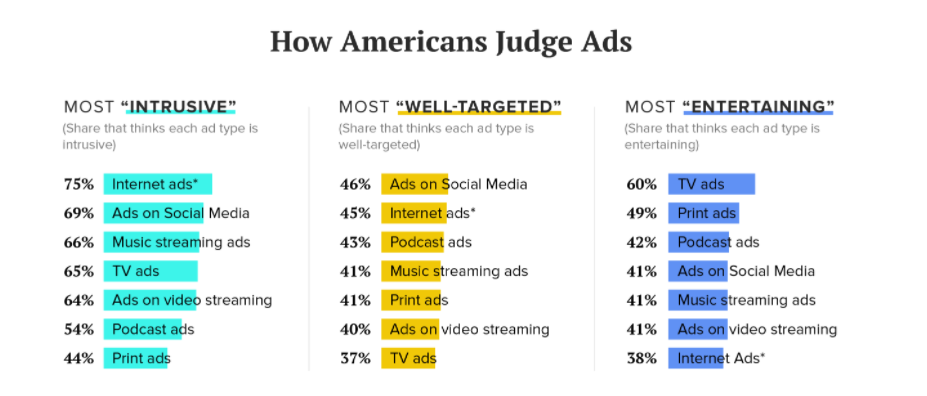It’s no surprise that people don’t like to be interrupted by ads while they’re reading a news article or watching TV or listening to music. Despite a strong dislike of advertising — from ads on websites to ads on social media to TV commercials to ads on music streaming platforms — Americans also appear to be reluctant to pay for an ad-free experience, according to a survey conducted by digital research firm Morning Consult.

Seventy-five percent of the U.S. adults surveyed by Morning Consult said they felt internet ads (social media ads got their own category) were “intrusive.” Sixty-nine percent felt social media ads were intrusive, 66 percent felt the same about music streaming ads, and 65 percent felt that way about TV ads. Sixty percent did report that they find television ads “entertaining,” but the share of people surveyed who found any of the other types of ads entertaining all fell below 50 percent. (The poll of 4,402 American adults was conducted between August 24 and September 8 of this year.)
Despite the lack of interest in most types of ads, 67 percent of those surveyed said they wouldn’t be willing to pay more for an ad-free version of a service. The survey also asked what one-time annual fee respondents might be willing to pay to get rid of ads:
When asked how much they’d be willing to pay in a yearly one-time fee in order to avoid ads on various media, the average price was $31 for television ads, and the figures fell into the $20 range for other platforms, including social media and news websites. That’s less than most people’s monthly phone bills and just enough to cover three months of the most basic service on Netflix, which doesn’t have ads.
That being said, younger viewers are willing to pay more, on average: Adults aged 34 and younger would pay about $41 to avoid television ads and just under $36 to eliminate ads on social media. Younger viewers also more likely than other age groups to use ad blockers, with 41 percent of those aged 18-29 saying they use one while browsing the web.
Thirty-two percent of those in the 18-29 demographic are also willing to pay to use an ad blocker, 8 percentage points higher than U.S. adults as a whole.
Younger consumers are a bunch to watch: This year’s Reuters Institute digital news report found that in the U.S., the proportion of younger people paying for online news rose from 4 percent in 2016 to 18 percent in 2017 (there wasn’t much change on this front in other countries the report tracked).
2) @dcnorg has research showing audiences will absolutely pay for trusted News and Entertainment. But agree we want advertising success.
— Jason Kint (@jason_kint) September 24, 2017
Only seen a draft. Next month will push to release as much as we can. It’s an internal member-only benchmark.
— Jason Kint (@jason_kint) September 24, 2017
The Morning Consult writeup is available here.
Leave a comment